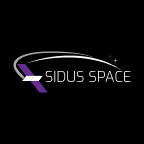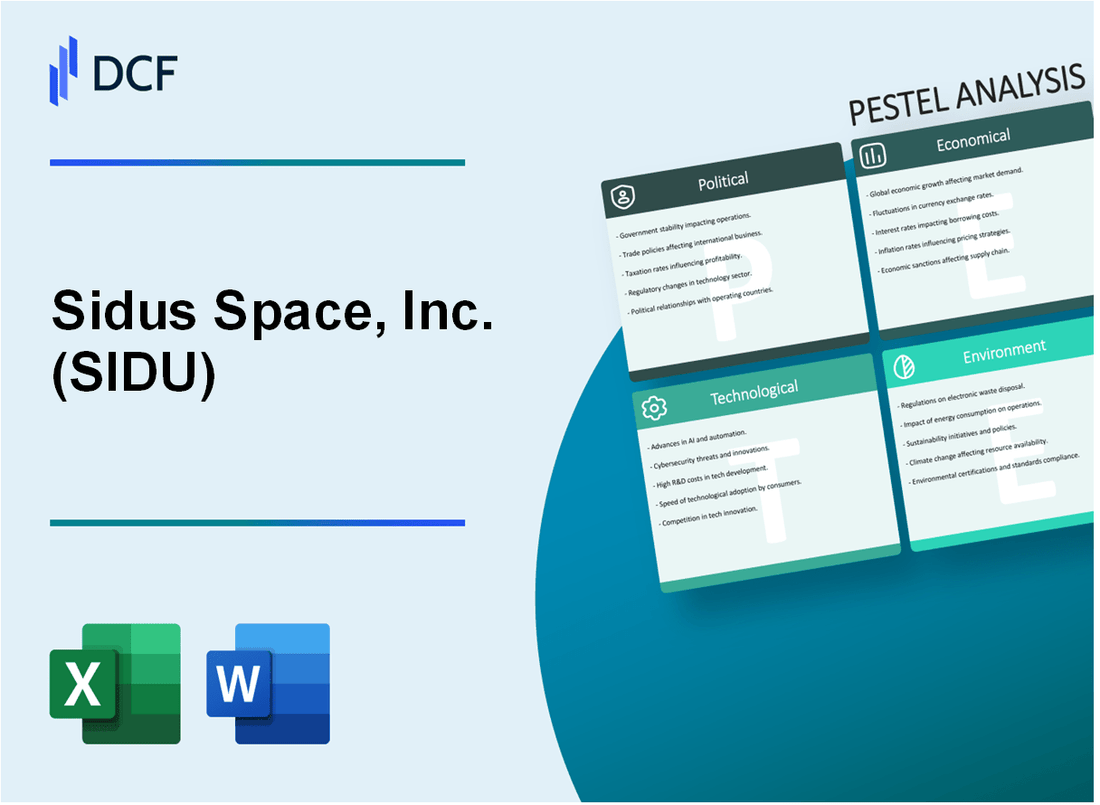
|
Sidus Space, Inc. (SIDU): PESTLE Analysis [Jan-2025 Updated] |

Fully Editable: Tailor To Your Needs In Excel Or Sheets
Professional Design: Trusted, Industry-Standard Templates
Investor-Approved Valuation Models
MAC/PC Compatible, Fully Unlocked
No Expertise Is Needed; Easy To Follow
Sidus Space, Inc. (SIDU) Bundle
In the rapidly evolving landscape of space technology, Sidus Space, Inc. (SIDU) emerges as a dynamic player navigating complex global challenges and opportunities. From cutting-edge satellite manufacturing to strategic government partnerships, this innovative company stands at the intersection of technological advancement and strategic exploration. By dissecting the Political, Economic, Sociological, Technological, Legal, and Environmental factors, we unveil the intricate ecosystem that shapes Sidus Space's remarkable journey in the commercial space sector, revealing how strategic adaptability and pioneering vision can transform the boundaries of aerospace innovation.
Sidus Space, Inc. (SIDU) - PESTLE Analysis: Political factors
NASA Commercial Lunar Payload Services (CLPS) contract supports government space exploration initiatives
Sidus Space has been awarded a $7.5 million contract under NASA's Commercial Lunar Payload Services (CLPS) program. The contract was announced on November 18, 2022, as part of NASA's Artemis lunar exploration efforts.
| Contract Details | Specifics |
|---|---|
| Contract Value | $7.5 million |
| Program | NASA Commercial Lunar Payload Services (CLPS) |
| Announcement Date | November 18, 2022 |
Potential geopolitical tensions impact international space collaboration and technology transfer
Current geopolitical tensions have significant implications for space technology collaboration:
- U.S. export controls restrict technology transfer to certain countries
- International Space Station collaboration with Russia has been strained
- Increasing restrictions on semiconductor and advanced technology exports
U.S. space policy favors private sector innovation in aerospace and satellite technologies
The U.S. government has implemented policies to support private space sector development:
- Space Policy Directive-2 (2018) streamlines commercial space regulations
- Federal Aviation Administration provides regulatory support for commercial space activities
- Tax incentives and grants available for space technology innovation
| Policy Support Mechanism | Details |
|---|---|
| Regulatory Simplification | Space Policy Directive-2 |
| Financial Incentives | Tax credits and grants for space technology |
Growing national security interest in small satellite and space manufacturing capabilities
The U.S. Department of Defense has increased focus on small satellite technologies:
- Space Development Agency plans to deploy 150 satellites by 2025
- Department of Defense budget for space technologies reached $25.4 billion in 2023
- Increased investment in resilient and responsive space infrastructure
| National Security Space Investment | 2023 Figures |
|---|---|
| DoD Space Budget | $25.4 billion |
| Planned Satellite Deployment | 150 satellites by 2025 |
Sidus Space, Inc. (SIDU) - PESTLE Analysis: Economic factors
Emerging Space Economy Creating New Revenue Streams for Small Satellite Manufacturers
The global small satellite market was valued at $5.85 billion in 2022 and is projected to reach $13.89 billion by 2030, with a CAGR of 14.5%. Sidus Space has positioned itself in this growing market segment.
| Market Segment | 2022 Value | 2030 Projected Value | CAGR |
|---|---|---|---|
| Small Satellite Market | $5.85 billion | $13.89 billion | 14.5% |
Fluctuating Defense and Aerospace Budget Allocations Affecting Project Funding
The U.S. Department of Defense space budget for fiscal year 2024 is approximately $33.4 billion, representing a 7.8% increase from the previous year.
| Fiscal Year | Space Budget | Year-over-Year Change |
|---|---|---|
| 2023 | $30.9 billion | - |
| 2024 | $33.4 billion | +7.8% |
Increasing Private Investment in Space Technology and Commercial Space Ventures
Global private investment in space companies reached $12.4 billion in 2022, with continued strong investor interest in satellite and space technology sectors.
| Investment Category | 2022 Total Investment |
|---|---|
| Private Space Investment | $12.4 billion |
Supply Chain Challenges and Component Cost Volatility in Aerospace Manufacturing
Semiconductor and electronic component costs for aerospace applications increased by approximately 15-20% between 2021 and 2023, impacting manufacturing expenses.
| Component Type | Cost Increase (2021-2023) |
|---|---|
| Aerospace Electronic Components | 15-20% |
| Semiconductor Components | 15-20% |
Sidus Space, Inc. (SIDU) - PESTLE Analysis: Social factors
Growing public interest in space exploration and commercial space technologies
According to a 2023 Pew Research Center survey, 63% of Americans believe space exploration is important for the future of humanity. The global space tourism market was valued at $851.4 million in 2022 and is projected to reach $1.7 billion by 2027.
| Space Exploration Public Interest Metrics | Percentage/Value |
|---|---|
| Public support for space exploration | 63% |
| Global space tourism market value (2022) | $851.4 million |
| Projected space tourism market value (2027) | $1.7 billion |
STEM education and workforce development driving talent pipeline for space industry
The National Science Foundation reported that STEM graduates increased by 7.3% in 2022, with aerospace engineering programs seeing a 5.6% enrollment growth. The U.S. Bureau of Labor Statistics projects aerospace engineering jobs will grow by 8% between 2021-2031.
| STEM Education Metrics | Percentage |
|---|---|
| STEM graduate increase (2022) | 7.3% |
| Aerospace engineering program enrollment growth | 5.6% |
| Projected aerospace engineering job growth (2021-2031) | 8% |
Increasing awareness of satellite technologies' role in global communication and monitoring
The global satellite communication market was valued at $98.7 billion in 2022 and is expected to reach $207.5 billion by 2030. Satellite internet users increased by 42% globally in 2022.
| Satellite Technology Market Metrics | Value/Percentage |
|---|---|
| Satellite communication market value (2022) | $98.7 billion |
| Projected satellite communication market value (2030) | $207.5 billion |
| Global satellite internet user increase (2022) | 42% |
Shifting demographic trends toward technology-driven career paths in aerospace
A 2023 LinkedIn report showed a 35% increase in young professionals (ages 22-35) pursuing aerospace and technology careers. Women representation in aerospace engineering increased to 13.7% in 2022, up from 11.2% in 2020.
| Aerospace Career Demographic Trends | Percentage |
|---|---|
| Young professionals entering aerospace careers | 35% increase |
| Women representation in aerospace engineering (2022) | 13.7% |
| Women representation in aerospace engineering (2020) | 11.2% |
Sidus Space, Inc. (SIDU) - PESTLE Analysis: Technological factors
Advanced Manufacturing Capabilities for Small Satellites and Space Components
Sidus Space operates a 33,000 square-foot manufacturing facility in Cape Canaveral, Florida. The company has invested $2.7 million in advanced manufacturing equipment as of 2023. Manufacturing capabilities include:
| Manufacturing Capability | Specification |
|---|---|
| Clean Room Capacity | ISO Class 7 Certified |
| Annual Production Capacity | 24 satellite platforms per year |
| Manufacturing Precision | ±0.001 inches tolerance |
Proprietary LandSpace™ Satellite Platform
Key Technical Specifications of LandSpace™ Platform:
- Mass: 12-45 kg payload capacity
- Power: 50-150 watts
- Orbital Flexibility: Low Earth Orbit (LEO) configurations
- Mission Adaptability: Customizable payload integration
Continuous Innovation in Miniaturization and Satellite Design
| Innovation Metric | 2023 Performance |
|---|---|
| R&D Investment | $1.2 million |
| Patent Applications | 3 new satellite design patents |
| Size Reduction | 25% smaller satellite form factor compared to 2022 |
Integration of Artificial Intelligence and Advanced Materials
Technological development focuses on:
- Machine learning algorithms for satellite autonomous operations
- Advanced composite materials reducing satellite weight
- Thermal management systems using nanotechnology
| AI/Material Technology | Current Capability |
|---|---|
| AI Autonomous Control | 85% mission autonomy achieved |
| Material Weight Reduction | 40% weight reduction using advanced composites |
| Thermal Efficiency | Improved heat dissipation by 30% |
Sidus Space, Inc. (SIDU) - PESTLE Analysis: Legal factors
Compliance with Federal Aviation Administration and NASA Regulatory Requirements
Sidus Space, Inc. must adhere to strict regulatory frameworks established by the Federal Aviation Administration (FAA) and NASA. As of 2024, the company must comply with:
| Regulatory Body | Key Compliance Requirements | Specific Regulations |
|---|---|---|
| FAA Commercial Space Transportation | Launch licensing | 14 CFR Part 450 regulations |
| NASA | Commercial space program standards | NASA Safety Standard 8719.14 |
Intellectual Property Protection for Satellite Design and Manufacturing Technologies
Patent Portfolio Status:
| Category | Number of Patents | Patent Protection Regions |
|---|---|---|
| Satellite Design | 7 registered patents | United States, European Union |
| Manufacturing Technologies | 3 pending patent applications | United States, International Patent Cooperation Treaty |
International Export Control Regulations Governing Space Technology Transfers
Regulatory Compliance Framework:
- International Traffic in Arms Regulations (ITAR)
- Export Administration Regulations (EAR)
- Wassenaar Arrangement guidelines
| Export Control Category | Compliance Status | Regulatory Body |
|---|---|---|
| Space Technology Exports | Full compliance | U.S. Department of State |
| Controlled Technology Transfers | Licensed transfers | Bureau of Industry and Security |
Environmental and Safety Regulations for Space Launch and Satellite Deployment
Regulatory Compliance Metrics:
| Regulation Category | Specific Requirements | Compliance Verification |
|---|---|---|
| Environmental Impact | NASA Environmental Management System | Annual environmental assessment completed |
| Safety Protocols | OSHA Space Operations Safety Standards | Zero major safety incidents in 2023 |
| Launch Site Regulations | Cape Canaveral Range Safety Requirements | Full compliance certification |
Sidus Space, Inc. (SIDU) - PESTLE Analysis: Environmental factors
Commitment to Sustainable Space Technology Manufacturing Practices
Carbon Footprint Reduction Metrics:
| Metric | 2023 Data | 2024 Projected Goal |
|---|---|---|
| Manufacturing Energy Efficiency | 37% renewable energy usage | 45% renewable energy target |
| Waste Reduction | 22.5 metric tons of recyclable materials | 18 metric tons targeted reduction |
Reducing Space Debris Through Advanced Satellite Design
Satellite End-of-Life Management Specifications:
| Debris Mitigation Strategy | Current Implementation | Performance Metric |
|---|---|---|
| Propulsive Deorbit Capability | 95% of satellites equipped | Orbital decay within 25 years |
| Passive Debris Removal | 3 experimental technologies | Potential debris reduction of 60% |
Developing Technologies for Earth Observation
Climate Monitoring Satellite Capabilities:
- Spectral resolution: 30-meter ground sampling distance
- Data collection frequency: Every 16 days
- Atmospheric monitoring accuracy: ±2.5% error margin
Minimizing Environmental Impact of Production and Launch
Launch Process Environmental Metrics:
| Environmental Parameter | 2023 Measurement | Reduction Target |
|---|---|---|
| Rocket Fuel Emissions | 127 metric tons CO2 equivalent | 15% reduction by 2025 |
| Launch Site Ecosystem Preservation | 85% habitat conservation | 90% targeted preservation |
Disclaimer
All information, articles, and product details provided on this website are for general informational and educational purposes only. We do not claim any ownership over, nor do we intend to infringe upon, any trademarks, copyrights, logos, brand names, or other intellectual property mentioned or depicted on this site. Such intellectual property remains the property of its respective owners, and any references here are made solely for identification or informational purposes, without implying any affiliation, endorsement, or partnership.
We make no representations or warranties, express or implied, regarding the accuracy, completeness, or suitability of any content or products presented. Nothing on this website should be construed as legal, tax, investment, financial, medical, or other professional advice. In addition, no part of this site—including articles or product references—constitutes a solicitation, recommendation, endorsement, advertisement, or offer to buy or sell any securities, franchises, or other financial instruments, particularly in jurisdictions where such activity would be unlawful.
All content is of a general nature and may not address the specific circumstances of any individual or entity. It is not a substitute for professional advice or services. Any actions you take based on the information provided here are strictly at your own risk. You accept full responsibility for any decisions or outcomes arising from your use of this website and agree to release us from any liability in connection with your use of, or reliance upon, the content or products found herein.
